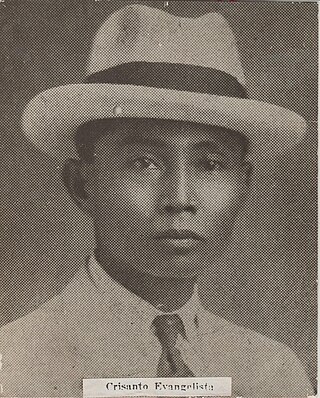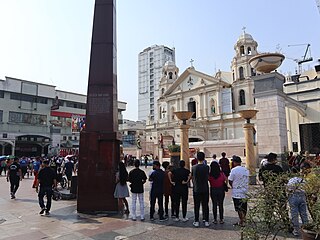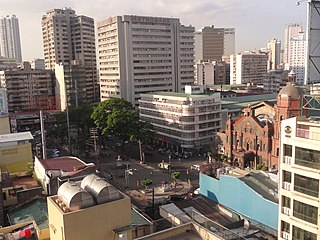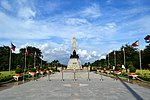
The Communist Party of the Philippines is a far-left, Marxist–Leninist–Maoist revolutionary organization and communist party in the Philippines, formed by Jose Maria Sison on 26 December 1968.
Ruben Deloso Torres is a Filipino politician and former communist leader. He went by the nom de guerre "Kadre" while he was a member of the Partido Komunista ng Pilipinas (PKP) from the 1960s to the 1970s.

The 1935 Philippine presidential and vice presidential elections were held on September 16, 1935. This was the first election since the enactment of the Tydings–McDuffie Act, a law that paved the way for a transitory government, as well as the first nationwide at-large election ever held in the Philippines.

Crisanto Abaño Evangelista was a Filipino communist politician and labor leader of the first half of the 20th century. He is credited as being one of the founders of the Partido Komunista ng Pilipinas. Evangelista was also an influential head of the Congreso Obrero de Filipinas, at the time the foremost and largest trade federation in the Philippines, having served as secretary for multiple years. He also headed the Union de Impresores de Filipinas as its Secretary-General. Prior to forming the PKP, Evangelista was a member of the Partido Obrero de Filipinas, a Filipino workers' party with increasingly radical leanings. Evangelista was eventually captured by the Japanese during the Second World War and executed.

Plaza Miranda is a public square bounded by Quezon Boulevard, Hidalgo Street and Evangelista Street in Quiapo, Manila. It is the plaza which fronts the Minor Basilica and National Shrine of Jesus Nazareno, one of the main churches of the City of Manila and is considered the center of Quiapo as a whole. Inaugurated in its current form by Mayor Arsenio Lacson in 1961, it is named after José Sandino y Miranda, who served as the Philippines' Secretary of the Treasury between 1833 and 1854.

The Partido Komunista ng Pilipinas-1930 (PKP-1930), also known as the Philippine Communist Party, is a communist party in the Philippines that was established on November 7, 1930. It uses the aforementioned appellation in order to distinguish itself from its better known splinter group, the Communist Party of the Philippines.
Guillermo Capadocia (1909–1951) was a Filipino communist politician and labour leader. He was a prominent leader of the Communist Party in the Philippines (PKP) and different labour movements. During the last one and a half years of his life he was a regional guerrilla commander of the Hukbalahap.

Plaza San Lorenzo Ruiz or Plaza Lorenzo Ruiz is a major public square in Binondo, Manila, bounded by Quintin Paredes Street to the east and Juan Luna Street to the west, parallel to the Estero de Binondo. It is the plaza that fronts the Minor Basilica of San Lorenzo Ruiz, one of the main churches of the City of Manila, and is considered the center of Binondo as a whole.

Dominador Gómez was a Filipino ilustrado nationalist, physician, writer, legislator, and a labor leader.

The history of communist armed conflicts in the Philippines is closely related to the history of communism in the Philippines, with various armed conflict linked to the armed wings of the various communist organizations that have evolved since 1930. The two largest conflicts have been the Hukbalahap rebellion of 1942–1954, and the ongoing rebellion of the New People's Army, which began in 1969 under the auspices of the Communist Party of the Philippines (CPP). But various splinter groups have since separated from the CPP and have had a history of armed conflict with the Philippine government since then.
Communism in the Philippines emerged in the first half of the 20th century during the American colonial era of the Philippines. Communist movements originated in labor unions and peasant groups. The communist movement has had multiple periods of popularity and relevance to the national affairs of the country, most notably during the Second World War and the Martial Law Era of the Philippines. Currently, the communist movement is weaker, and considered an insurgent movement by the Armed Forces of the Philippines.
José Baltazar Lava, also known as Peping or Harry, was the general secretary of the Partido Komunista ng Pilipinas-1930 (PKP), from 1948 until his arrest in 1950. He spent the following two decades in prison and another two decades in exile in Prague, Czechoslovakia.
The First Great Rectification Movement refers to a 1965 ideological movement by Filipino communists led by Jose Maria Sison wherein they "criticized, repudiated and rectified the major ideological, political and organizational errors and weaknesses" of the 1930s-era Communist Party of the Philippines. This rectification movement led to the reestablishment of the Communist Party of the Philippines on December 26, 1968 along Marxist–Leninist–Maoist Thought.
The Partido Obrero de Filipinas was a Marxist political party formed in 1924 by Filipino labor organizers Crisanto Evangelista, Domingo Ponce and Cirilo Bognot during the administration of the Insular Government of the Philippine Islands. This party later formed the core of the Partido Komunista ng Pilipinas which was established in 1930.

The Katipunan ng mga Anak-Pawis sa Pilipinas (KAP) was the third trade union federation in the Philippines. It was formed in 1929 after an antagonistic national convention of the Congreso Obrero de Filipinas where election results were manipulated, causing Crisanto Evangelista and his faction to split from the COF. In 1930, the KAP changed its name to Partido Komunista ng Pilipinas after it initiated the formation of a "mass political party" and questions arose regarding its name.
The Congress of Labor Organizations (CLO) was a trade union federation in the Philippines. It was formed in 1945 by Hukbalahap guerillas who had been members of the Collective Labor Movement. Its first president was Cipriano Cid of the Philippine Trade Union Council. The CLO controlled labor unions in all major industries in Panay and Manila, representing a significant percentage of the organized labor force therein and was the dominant labor federation of the period immediately after World War II.
Juan Feleo was a Filipino peasant leader and politician. He was one of the founders of one of the Philippines' leading peasant groups, the Kalipunang Pambansa ng Magbubukid sa Pilipinas and a top-ranking member of the Partido Komunista ng Pilipinas. He was also involved in the HUKBALAHAP, and his death sparked the subsequent Huk Rebellion.

The Anti-Subversion Act of 1957, officially designated as Republic Act No. 1700, is a Philippine law which outlawed the Communist Party of the Philippines of 1930, the Hukbalahap, and any organizations succeeding these two organizations including the Communist Party of the Philippines, the National Democratic Front of the Philippines, and the New People's Army, on the grounds that these groups is involved in a "conspiracy to overthrow the government and imposed a totalitarian regime". It also prohibited association with these groups.

Teodoro B. Asedillo was a Filipino labor leader and revolutionary. A former schoolteacher and police officer in Longos, he became the head of the labor federation Katipunan ng mga Anak-Pawis sa Pilipinas in his province of Laguna. He was also a member of the Partido Komunista ng Pilipinas-1930.












